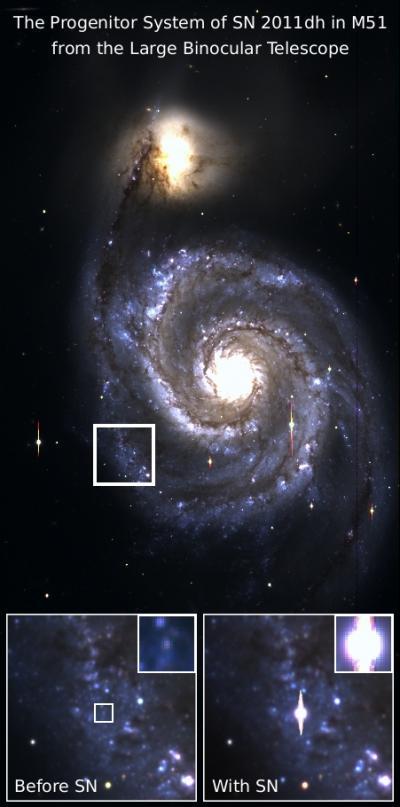COLUMBUS, Ohio – An otherwise nondescript binary star system in the Whirlpool Galaxy has brought astronomers tantalizingly close to their goal of observing a star just before it goes supernova.
The study, submitted in a paper to the Astrophysical Journal, provides the latest result from an Ohio State University galaxy survey underway with the Large Binocular Telescope, located in Arizona.
In the first survey of its kind, the researchers have been scanning 25 nearby galaxies for stars that brighten and dim in unusual ways, in order to catch a few that are about to meet their end. In the three years since the study began, this particular unnamed binary system in the Whirlpool Galaxy was the first among the stars they've cataloged to produce a supernova.
The astronomers were trying to find out if there are patterns of brightening or dimming that herald the end of a star's life. Instead, they saw one star in this binary system dim noticeably before the other one exploded in a supernova during the summer of 2011.
Though they're still sorting through the data, it's likely that they didn't get any direct observations of the star that exploded – only its much brighter partner.
Yet, principal investigator Christopher Kochanek, professor of astronomy at Ohio State and the Ohio Eminent Scholar in Observational Cosmology, does not regard this first result as a disappointment. Rather, it's a proof of concept.
"Our underlying goal is to look for any kind of signature behavior that will enable us to identify stars before they explode," he said. "It's a speculative goal at this point, but at least now we know that it's possible."
"Maybe stars give off a clear signal of impending doom, maybe they don't," said study co-author Krzystof Stanek, professor of astronomy at Ohio State, "But we'll learn something new about dying stars no matter the outcome."

This Large Binocular Telescope image below of the Whirlpool Galaxy, otherwise known as M51, is part of a new galaxy survey by Ohio State University, where astronomers are searching for signs that stars are about to go supernova. The insets show one particular binary star system before (left) and after (right) one of its stars went supernova.
(Photo Credit: Image by Dorota Szczygiel, courtesy of Ohio State University.)
Postdoctoral researcher Dorota Szczygiel, who led the study of this supernova, explained why the galaxy survey is important.
"The odds are extremely low that we would just happen to be observing a star for several years before it went supernova. We would have to be extremely lucky," she said.
"With this galaxy survey, we're making our own luck. We're studying all the variable stars in 25 galaxies, so that when one of them happens go supernova, we've already compiled data on it."The supernova, labeled 2011dh, was first detected on May 31 and is still visible in telescopes. It originated from a binary star system in the Whirlpool Galaxy – also known as M51, one of the galaxies that the Ohio State astronomers have been observing for three years.
The system is believed to have contained one very bright blue star and one even brighter red star. From what the astronomers can tell, it's likely that the red star is the one that dimmed over the three years, before the blue star initiated the supernova.
When the Ohio State researchers reviewed the Large Binocular Telescope data as well as Hubble Space Telescope images of M51, they saw that the red star had dimmed by about 10 percent over three years, at a pace of three percent per year.
Szczygiel believes that the red star likely survived its partner's supernova.
"After the light from the explosion fades away, we should be able to see the companion that did not explode," she said.
As astronomers gather data from more supernovae – Kochanek speculates that as many as one per year could emerge from their data set – they could assemble a kind of litmus test to predict whether a particular star is near death. Whether it's going to spawn a supernova or shrink into a black hole, there may be particular signals visible on the surface, and this study has shown that those signals are detectable.
The team won't be watching our sun for any changes, however. At less than 10 percent of the mass of the star in supernova 2011dh, our star will most likely meet a very boring end.
"There'll be no supernova for our sun – it'll just fizzle out," Kochanek said. "But that's okay – you don't want to live around an exciting star."
Source: Ohio State University